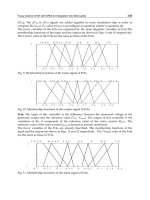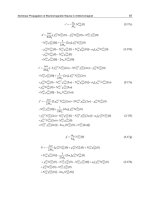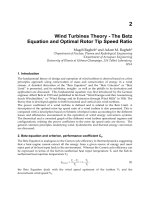Advanced Topics in Mass Transfer Part 5 docx
Bạn đang xem bản rút gọn của tài liệu. Xem và tải ngay bản đầy đủ của tài liệu tại đây (1.18 MB, 40 trang )
D D
D
CΦ
C
D
j I D I
Φ
j
I
C Φ
C
Φ
Φ
C K
K
BΘ
Φ
B
D
j I D I
Θ
B
Θ
Θ
B K
K
AF
Ψ
A
D a D a
F
Ψ
a
A Ψ
A
F
F
A K
K
AF
AF Ψ
Φ
F
F F
Ψ
A
F
F A P Ψ
f(η)
( )
η
f(η)
( )
η
f(η)
( )
η
f(η)
( )
η
f(η)
( )
η
f(η)
Ω
Ω
Ω
Ω
( )
η
f(η)
( )
η
θ(η)
Ω
Ω
Ω
Ω
( )
η
θ(η)
( )
η
θ(η)
( )
η
θ(η)
( )
η
φ(η)
γ
γ
γ
γ
( )
η
φ(η)
( )
on the Mass Transfer in Close Binary System
1. Introduction
The gravitational potential of a binary system is described by the Roche model where each
star dominates the gravitational potential inside regions called Roche lobes.The two Roche
lobes meet at the inner Lagrange point along the joining of the two stars. Figure 1 shows
equipotential surfaces in the orbital plane for a binary system. As may be seen from Fig. 1,
there are five equilibrium points( i.e.
∇φ = 0) three of which i.e., L
1
, L
2
, L
3
,are along the line
centers. Two are peripheral to the masses and lie as the critical points along equipotentials
that envelope both stars. two other points ,i.e., L
4
, L
5
lie opposite to each other, perpendicular
to the line of centers. These are quasi-equilibrium points for which local orbits are possible
because of coriolis acceleration. If either star fills its Roche lobe, matter will stream from
the Roche lobe filling star through the inner Lagrange point to the other star in a process
known as Roche lobe overflow(RLOF). This actually occurs before the photosphere reaches the
Roche lobe radius in the absence of magnetic fields or other constrains on the mass flow. This
mass transfer affects both the evolution of the components of the binary as well as the binary
properties such as orbital period and eccentricity. Roche lobe overflow can be triggered by the
evolution of the binary properties or by evolution of the component stars. On the one hand,
the orbital separation of the binary can change so that the Roche lobe can shrink to within the
surface of one of the stars. On the other hand, stellar evolution may eventually cause one of
the stars to expand to fill its Roche lobe. When both stars in the binary are main-sequence
stars, the latter process is more common. Since the more massive star will evolve first, it
will be the first to expand and fill its Roche lobe. At this stage, the mass exchange can be
conservative (no mass is lost from the binary) or non-conservative (mass is lost). Depending
on the details of the mass exchange and the evolutionary stage of the mass-losing star there are
several outcomes that will lead to formation of a relativistic binary. The primary star can lose
its envelope, revealing its degenerate core as either a helium, carbon-oxygen, or oxygen-neon
white dwarf, it can explode as a supernova, leaving behind a neutron star or a black hole,
or it can simply lose mass to the secondary so that they change roles. Barring disruption
of the binary, its evolution will then continue. In most outcomes, the secondary is now the
more massive of the two stars and it may evolve off the main sequence to fill its Roche lobe.
The secondary can then initiate mass transfer or mass loss with the result that the secondary
also can become a white dwarf (WD), neutron star (NS), or black hole (BH). The relativistic
binaries that result from this process fall into a number of observable categories. A WD-MS or
WD-WD binary may eventually become a cataclysmic variable once the white dwarf begins
to accrete material from its companion. If the companion is a Main Sequence star RLOF can
Davood Manzoori
Department of Physics, University of Mohaghegh Ardabili, P. O.Box. 179, Ardabil
Iran
8
2 Mass Transfer
Fig. 1. Roche surface for q = 0.4. The Lagrangian points are indicated
be triggered by evolution of the companion. If the companion is another white dwarf, then
RLOF is triggered by the gradual shrinking of the orbit through the emission of gravitational
radiation. WD-WD cataclysmic variables are also known as AM CVn stars. If the total mass
of the WD-WD binary is above the Chandrasekhar mass, the system may be a progenitor to
a type I supernova. The orbit of a NS-MS or NS-WD binary will shrink due to the emission
of gravitational radiation. At the onset of RLOF, the binary will become either a low-mass
X-ray binary(if the donor star is a WD or MS with M
1
≤2M
), or a high-mass X-ray binary(if
the donor is a more massive main-sequence star).These objects may further evolve to become
millisecond pulsars if the NS is spun up during the X-ray binary phase
1
. A comprehensive
table of close binary types that can be observed in electromagnetic radiation can be found in
Hilditch (2001). The type of binary that emerges depends upon the orbital separation and
the masses of the component stars. During the evolution of a 10M
star, the radius will
slowly increase by a factor of about two as the star progresses from zero age main sequence to
terminal age main sequence. The radius will then increase by about another factor of 50 as the
star transitions to the red giant phase, and an additional factor of 10 during the transition to
the red supergiant phase. These last two increases in size occur very quickly compared to the
slow increase during the main-sequence evolution of the star. Mass transfer can be divided
into three cases see (Thomas 1977) related to the timing of the onset of RLOF.
Case A: If the orbital separation is small enough (usually a few days), the star can fill its Roche
lobe during its slow expansion through the main-sequence phase while still burning hydrogen
in its core.
1
See the website,
164
Advanced Topics in Mass Transfer
Mass Transfer, and Effects of M agnetic Fields on the Mass Transfer in C lose Bi nary System 3
Case B: If the orbital period is less than about 100 days, but longer than a few days, the star
will fill its Roche lobe during the rapid expansion to a red giant with a helium core. If the
helium core ignites during this phase and the transfer is interrupted, the mass transfer is case
B.
Case C: If the orbital period is above 100 days, the star can evolve to the red supergiant phase
before it fills its Roche lobe. In this case, the star may have a CO or ONe core.
Case A mass transfer occurs during the slow growth, case B during the first rapid expansion,
and case C during the final expansion phase. The nature of the remnant depends upon the
state of the primary during the onset of RLOF and the orbital properties of the resultant binary
depend upon the details of the mass transfer.
Wood (1950) studied period variations of binaries and suggested that mass ejections could
be a cause of period change. Huang (1963) revised the problem of mass transfer in binary
systems, he modified the Jeans(1924-1925) mode of mass ejection, through suggesting two
modes of mass transfer i.e., slow and intermediate modes, in each case he was able to derive
the following equations:
ΔP
P
= −3(
M
2
− M
1
M
2
)
ΔM
1
M
1
+
3eΔe
1 −e
2
forslowmode (1)
ΔP
P
=(1 + 3γ
2
)(
M
2
+ M
1
M
1
+ M
2
) −3
ΔM
1
M
1
+
ΔM
2
M
2
+
3eΔe
1 −e
2
forintermediatemode (2)
Where
γ
2
=
(
M
1
+ M
2
)
2
M
1
M
2
[
a
e
a(1 −e
2
)
]
1/2
P, denotes the orbital period, M
i
s, the masses of the components, e, eccentricity, a, semi-major
axis, and Δ implies the variations of respective parameters. A true review of mass and angular
momentum transfer and their consequences on the evolution of binary stars may be find by
Thomas (1977).
2. Conservative mass transfer
When no ejected matter leaves a binary system, the mass transfer is said to be conservative.
During consevative mass transfer, the orbital elements of the binary can change due to transfer
of angular momentum from one star to the companion. Consider a system with a totat mass
M
= M
1
+ M
2
, semi-major axis, a, eccentricty, e, and the total orbital angular momentum, J,
J
= M
1
M
2
Ga(1 −e
2
)
M
1
+ M
2
(3)
will also be conserved, where G, is universal grvitational constant. Hence:
˙
J
= 0,
˙
M =
0 and
˙
M
1
=
˙
−M
2
.AndWemayalsowrite
a
= c
2
(M
1
M
2
)
−2
J
2
(4)
Where:
c
=
M
G(1 −e
2
)
165
Mass Transfer, and Effects of Magnetic Fields on the Mass Transfer in Close Binary System
4 Mass Transfer
, c is a constant
Differentiating eq. 3 yields
˙
a
a
= 2
˙
J
J
−2
˙
M
1
M
1
−2
˙
M
2
M
2
+
˙
M
M
(5)
Using the requirements for conservative mass transfer (mentioned just after the eq. 3) in eq. 5
we get
˙
a
a
= 2
˙
M
1
(
M
2
− M
1
M
1
M
2
) (6)
If M
1
is the mass losing star
˙
M
1
will be negative, therefore we conclude that if the mass donor
star is more massive, then the orbit will shrink and hence period decreases. But if the mass
donor is less massive than the accretor component then orbit will be widened and period
increases.
By using the Kepler’s third law
(
P
2
a
3
=
4π
2
GM
) in eq. 6, the period variation with time
˙
P due to
mass transfer can be written as,
˙
P
=
3
˙
M
1
(M
1
− M
2
)
M
1
M
2
P (7)
Where P, is the orbital period.
3. Non conservative mass transfer
In case of non conservative mass transfer both mass and angular momentum can be removed
from the system. Following Demircan et al. (2006) Orbital Angular Momentum (OAM) of a
two body system is given by
J
=(
M
1
M
2
M
1
+ M
2
)a
2
Ω =(
q
(1 + q)
2
)Ma
2
Ω (8)
Where,
(
M
1
M
2
M
1
+ M
2
)a
2
= I
is moment of Inertia and Ω
=
2π
P
is angular speed, P, is orbital period and M = M
1
+ M
2
,
q
=
M
2
M
1
are total mass and mass ratio, respectively. If we assume isotropic mass loss from the
surface of the components, then,
˙
J
=(
q
(1 + q)
2
)
˙
Ma
2
Ω (9)
Since the dynamics of a two body system obey Kepler’s third law therefore one expects
transfer of mass would change the, a, P and M accordingly,
3
˙
a
a
+ 2
˙
Ω
Ω
=
˙
M
M
(10)
assume q as a constant, differentiation of equation 8 with respect to ”t”, will give
˙
J
J
=
˙
M
M
+ 2
˙
a
a
+
˙
Ω
Ω
(11)
166
Advanced Topics in Mass Transfer
Mass Transfer, and Effects of M agnetic Fields on the Mass Transfer in C lose Bi nary System 5
if
˙
a
a
is substituted from equation 10 to equation 11 we get,
˙
J
J
=
5
3
˙
M
M
−
1
3
˙
Ω
Ω
=
5
3
˙
M
M
+
1
3
˙
P
P
(12)
But substitution of
˙
Ω
Ω
from 10 in to 11 will give
˙
J
J
=
3
2
˙
M
M
+
1
2
˙
a
a
(13)
Therefore the last two equations i.e. 12 and 13, give how the loss of OAM and mass are caused
the orbital period, P, and orbital radius, a, to change.
According to equations 8 and 9 the isotropic mass loss implies
˙
J
=
˙
M
M
J (14)
This eq. implies that the only source of OAM loss is mass loss, which were assumed to be
isotropic. Substituting
˙
J
J
from eq 14 to 12 will give,
˙
P
= −2
˙
M
M
P (15)
In this last eq. since the
˙
P
P
is measurable observationally, therefore
˙
M
M
can be calculated from
eq. 15.
Now if we use the following eqs. taken from Stepien (1995) to calculate relative angular
momentum lost from a system as,
J
= G
2/3
M
5/3
Ω
−1/3
q(1 + q)
−2
(16)
J
lost
=
˙
J
= −
1
3
G
2/3
M
5/3
Ω
−4/3
q(1 + q)
−2
˙
Ω (17)
and hence the relative OAM lost only by magnetized star wind
J
lost
J
= −
1
3
˙
Ω
Ω
(18)
Where
˙
Ω
= 1.8 ×10
−8
(
k
2
(M
1
R
2
1
+ M
2
R
2
2
)(1 + q)
2
qG
2/3
M
5/3
)Ω
7/3
e
−1.3Ω
(19)
Using the value of
J
lost
J
in eq. 14, the relative mass lost from the system can be estimated. Since
eq.15 may give the total mass ejected from the system. Hence the transferred mass from one
component to the other easily can be estimated.
167
Mass Transfer, and Effects of Magnetic Fields on the Mass Transfer in Close Binary System
6 Mass Transfer
4. Effects of magnetic fields on the mass loss and mass transfer
Now it is generally accepted among the astrophysicists that close binary systems with a cool
F-K type star display enhanced magnetic activities. Short period close binaries i.e., those
having an orbital period P
< 5 −6 days, possess the just mentioned characteristics, due to
rapid rotation (Richard & Albright 1993). Many authors (see e.g., Richards 1993, 1992; Hall
1989 & Olson 1981) have discussed that the secondary and/or primary in the close binaries
having a late type component show a variety of time dependent magnetic properties, which
causes brightness variations in the light curve, radiations of X-ray, Ultraviolet, infrared, and
cyclic variations in the orbital period of the binary.
Generations of Polidal and Toroidal magnetic Fields:It is a well known fact that the dynamo
mechanism is likely cause of large scale magnetic field productions in the stars having
convective layers (e.g., see parker, 1955). The differential rotation between the radiative
core and convective envelope, winds up the field and causes a deformation (shearing) of
the poloidal field which, in turn, generates an additional toroidal field component and thus
creates a Lorentz force which counteracts the shear due to the poloidal field.
The effects of magnetic fields on the mass and angular momentum transfer and / or loss
of both the companions are quiet appreciable. In a close binary, where the spin and orbital
angular momenta are strongly coupled. This stellar spindown, forces a decrease in the
orbital period of the system even without mass transfer.The coupling constant depends on
the magnetic field strength and can be important if the field is strong enough (on the order or
few mega gauss). Another effect of the magnetic field is to alter the spin through torquing of
the star by mass outflow (see next section).
5. Magnetic braking
The net results of the mass exchange is a mass transfer from the primary to secondary during
whole contact phase (Huang et al. 2007). In addition the magnetic braking is a common
phenomenon to all the contact binary stars (see Bradstreet and Guinan 1994; Huang et al.
2007).
According to Bradstreet and Guinan (1994), Stepien (1995, 2006) the role of AM loss is crucial
in the formation and evolution of the contact low mass binary stars. The magnetized star
winds move outward from the active star, but are twisted due to rapid rotation of the star.
Charged particles in the star wind get trapped in the magnetic field of the star and are
dragged along the field lines. The result is Angular Momentum (AM) transfer from the star by
magnetic field to the charged particles. As the winds leave the star surface they are dragged
by the magnetic field which, in turn, slows down the rotation of star. For close binaries in
which synchronization of rotational and orbital period is expected, loss of rotational angular
momentum occurs at the expense of orbital AM. As a result, the period decreases (consistent
with the observations) i.e., the components spin up and approach one another to form a
single rapid rotating star (see Stepien 1995; Skumanich 1972). As stated by Stepien (1995,
2006) contact binary stars are magnetically very active and it is generally accepted that they
lose mass and Angular Momentum (AM) via magnetized wind. Moreover the separation
of the components is relatively low. Therefore, one expects the magnetic field interactions
between the two components to be intensified and consequently its effect on the AM loss to be
enhanced, due to the formation of magnetic loops between the surface magnetic fields of the
components (see Fig 2 & 3). This statement is consistent with the Bradstreet and Guinan (1994)
that the magnetic torque produced by magnetic field in the wind depends on the strength of
168
Advanced Topics in Mass Transfer
Mass Transfer, and Effects of M agnetic Fields on the Mass Transfer in C lose Bi nary System 7
magnetic field. But the details of this idea and its quantitive formulations and experimental
verifications will remain a challenge for the future.
The particles in the stellar winds that leave the star radially, at the stellar surface, their
tangential velocity components are equal to the rotational surface velocity of the star. (e.g., for
the Sun this velocity v
surf
= 2km/s). When the same particle are traveled to outer space, it is
expected to slow down to much lower velocities at large distances (e.g. for the Sun particles at
earth distance, a
= 1.5 ×10
8
km, v
surf
=
R
a
×2 1 ×10
−2
provided the angular momentum
(of the star is conserved). But in the case the Sun, the particles velocities measurements by
spacecrafts (e.g. Helios) is in order of 1-10 km/s. That is 10
2
− 10
3
times faster than the
expected velocities, the cause is that charged particles travel along the twisted open field lines
and not just radially outwards. Therefore the magnetic energy of the field per unit volume
must be much larger than the particle’s kinetic energy and thus its trajectory is dominated
by direction of magnetic field lines rather than gravitional field (see Strassmier 2001) and
references there in). If some of the stellar magnetic field lines are open and reconnect, with
companion star, then the particles either may collide with the parties which were guided by
the companion star along the field lines in similar fashion to the primary star, or may fall in
to the atmosphere of the companion star. (see the Figs. 2 & 3). These charged particles would
carry the angular momentum of the star with themselves.
With this picture in mind, as explained earlier, the magnetic field lines are bent due to rapid
rotation of the star, their curvature cause a counteract force on the surrounding stellar plasma
if we assume that magnetic poles are coinciding with the rotation poles, then the dissipated
angular momentum is very small and braking is almost negligible. But if field is anchored
at or near the equatorial plane then the braking would be strongest and therefore maximum
angular momentum is removed. Observations indicate that magnetic braking must be very
effective for the observable surface, is larger in the late F-K type stars.
Due to tidal interaction between the components in binary systems, the component stars rotate
much faster (10-100 times) as compared to a single star, therefore one expects the magnetic
fields production in the surfaces (subsurface) of the components in binaries containing one or
both components as late (F-K) type stars to be much stronger as compared with a single star
(Yuan & Quian, 2007, eq. 7) the magnetic force is sensitive to
(a
−4
), the central separation
between the components, but face to face separation between two components is much
smaller as compared to central separation ( i.e., a). The two magnetic fields as pictured above
are superposed (see Fig. 4)
There are some observational evidences to support the above picture. Lestrade (1996) detected
radio emissions from intra - binary region of the stars UX Ari and 2 CrB, which he attributed
to gyro synchrotron process associated with large scale magnetic fields. Siarkowski (1996)
used X - ray light curves of RS CVn binary AR Lacertae to map spatial structure of its corona,
and found regions of enhanced X - ray emission and extended structures that interconnect the
two stars. Gunn et. al. (1999) presented radio interferometeric observations of Algol- type
binary V 505 Sagittarii and modulated radio flux density levels with evidence of eclipses of
the emission regions of both conjunctions of the binary. The form of the light curve obtained
implied that the radio source involves at least some enhanced emission in the intra - binary
active regions. Gunn et. al. (1994), made EUV radio observations of active RS CVn binary CF
Tucanae, their observations indicated an, active intra - binary region and field interaction in
active close binary (see Figs. 2 & 3)
Uchida and Sakurai (1985) discussed the formation of corona and origin of flares in RS CVn
binaries having starspots, and interpreted in terms of reconnection of the magnetic flux tubes
169
Mass Transfer, and Effects of Magnetic Fields on the Mass Transfer in Close Binary System
8 Mass Transfer
Fig. 2. Formation of large scale magnetic loops between two components of a binary star.
(Taken from Uchida & Skurai 1985)
of the companion star, they found that the injection of the hot plasma in to the large scale
Pole - to - spot connections was required to explain the extended corona with large emission
measure they attributed this to the sweeping - pinch mechanism ( see Uchida & Shibata, 1984)
Fig. 3. Formation of large scale magnetic loops between two components of a binary star.
(Taken from Uchida & Skurai 1985)
170
Advanced Topics in Mass Transfer
Mass Transfer, and Effects of M agnetic Fields on the Mass Transfer in C lose Bi nary System 9
Fig. 4. Schematic sketch of magnetic field structure for a RS CVn binary star when both the
components are magnetically active (Taken from Yuan & Quian 2007)
associated in the twisted magnetic flux tubes which emerge and reconnect with the flux tubes
connecting poles and spots. Uchida & Shibata (1985) proposed a jet formation mechanism in
which a packet of the toroidal component of magnetic field (Bφ)playsarole.Suchapacketof
toroidal field produced by the action of rapid rotation of the star in the region where β
=
P
g
P
m
1. They showed the jet can be accelerated when toroidal component of the field emerges from
the β
>> 1regiontotheβ 1 region. When this happens a progressive pinch is produced
through the relaxation of the field and mass is ejected out by pinch near the magnetic axis and
also by J
×B force in the twisted field region surrounding the axis.
6. Conclusions
In Algol type binaries one outcome of conservative mass transfer through Roche lobe
filling mechanism of late secondary component is circumbinary disk, which can significantly
influence the orbital evolution and cause the orbit to shrink on a sufficiently long time scale.
Rapid mass transfer in Algols with low mass ratio can also be accounted for by this scenario.
The observed decrease in orbital periods of some Algol binaries (see Manzoori, 2007, 2008
manzoori & Ghozaliasl 2007) suggests OAM loss and magnetic braking mechanism, during
the binary evolution.
One of the interesting evolutionary consequences of mass transfer discovered in recent
years, is the formation of double contact binaries. It seems the concept of double contact
binaries first was introduced by Wilson (1979), as type of close binary which occurs only for
nonsynchronism, the binaries in which both components fill their limiting lobes, naming them
as double contact may be misguiding, because they do not even have a single contact point.
This can occur, when at least one of the components rotates faster than synchronously, so that
its limiting lobe is smaller than the respective Roche lobe (and the limiting lobe would be
bigger than Roche lobe if it rotates slower than synchronously). The situation can occur as a
natural consequence of mass transfer, because transfer normally spins -up an accreting star by
converting orbital to rotational angular momentum.
As stated earlier in section 1, one of the main characteristics of (semidetached, Algol- type)
binaries is mass transfer due to Roche lobe filling of late secondary component. Such mass -
exchange will spin -up the mass accreting star (most of whose mass is transferred material,
by the end of rapid phase of mass transfer). But according to Wilson et al. (1985) this rapid
rotation will be damped quickly, as soon as mass transfer is stopped. Among semidetached
systems there are few members which show asynchronous rotation, see table 1 of the Wilson
and Twigg (1980). Thus, near to or after the end of rapid phase of mass transfer, the mass
losing star would normally be found to fill its Roche lobe (rotating synchronously), while the
171
Mass Transfer, and Effects of Magnetic Fields on the Mass Transfer in Close Binary System
10 Mass Transfer
accreting star (or perhaps only its outer envelope) may have accommodated all of its capacity
of the angular momentum which can hold, and so fill its limiting ”rotational” lobe. According
to Wilson and Caldwell (1978) the β- Lyrae and V356 Sgr and also U Cep and some of the
Algol type systems are most likely candidates of double contact binaries. A main evolutionary
consequence of their finding of double contact is that, since the accreting star after filling the
limiting lobe will not be able to accommodate any more of the new high angular momentum
material transferred by donor star, therefore such a system must find an alternate way for
accommodation of the transferred matter, as first noted by Wilson and Caldwell (1978); this
is a probable explanation for the thick circumstellar disks seen in β Lyr and V356 Sgr, and is
perhaps related to numerous strange effects seen is U Cep (see Manzoori 2008). Notice that
the existence of double contact systems introduce a symmetry in to the morphology of close
binaries, in that stars may fill lobes exactly not only as a result off mass loss, but also as a result
of mass gain.
The disk formed as mentioned, reduces a substantial fraction of the primary’s light and
therefore the star appears relatively under luminous, therefore it should make primary eclipse
shallower than expected (see Manzoori 2006, 2008). For the same reason it would reduce also
the irradiation of the secondary light by the primary, (reduces reflection effect), if the disk
emits relatively little light of its own, the effect of its eclipse by the secondary star will be slight,
but the eclipse of the secondary by the disk should be appreciable. Thus secondary eclipse
should be wider than primary eclipse, and should also be deeper than it would be without an
eclipse by the disk. One of the main conditions of the existence of double contact phase in the
evolution of binary stars is nonsynchronous rotation of mass accreting component reaching
the centrifugal limit. Naturally a star can not exceed its limiting rotational lobe because its
equatorial matter would then be centrifugally unbound (see Wilson, 1983). The discovery of
only very few members of this type of binaries, might be due to relatively brief time scale for
binary to spend in double contact phase according Li et al. (2006).
According to Bradstreet and Guinan (1994) in close binary systems with period P
< 0.5d,
where tidal forces are strong enough to cause synchronization of the components, the role of
spin -orbit coupling becomes important in evolution of the binary and angular mentum loss
from the system through magnetic braking spin up with time, and orbital period decreases.
Consequently magnetic activity of the stars increases. This process can cause a detached
binary composed of late type components to become a short period contact W UMa - type
binary. Webbink (1976, 1985) stated that in short period contact binaries with period P
< 0.5d,
after formation the loss of angular momentum through gravitational radiations play an
important role in the evolution of the system and loss of angular momentum can ultimately
lead to the coalescence of the binary system in to a single star. It is believed now the rapidly
rotating F-K Com G - type gaint stars with intense H
α
emissions are formed in this way.
According to Stepien (1995; 2006) W UMa stars are magnetically very active and it is generally
accepted that they lose mass and Angular Momentum (AM) via magnetized wind. Gazeas
and Stepien (2008), analyzing over hundred cool contact binaries, found several correlations
among the geometrical and physical parameters and they stated that ”the coalescence of both
components in to a single fast rotating star, is the final fate of contact binaries”. This statement
is not agreed with that of the Li et al. (2005). Li et al. in a series of three papers (2004a; 2004b;
2005) discussed the structure and evolution of low mass contact binaries, with and without
spin and orbital angular momentum loss, and taking in to account effects of energy transfer,
with negligible gravitational radiation. They presented an ultimate model of W UMa systems
exhibiting cyclic evolution around a state of marginal contact, in time scales of about 6
×10
6
yr,
172
Advanced Topics in Mass Transfer
Mass Transfer, and Effects of M agnetic Fields on the Mass Transfer in C lose Bi nary System 11
without loss of contact, if spin angular momentum of both components are included; 9 ×10
6
yr, if spin angular momentum of both components are neglected. According to them, the
ratio of spin angular moment of both components to the orbital angular momentum of the
system becomes larger as the evolution proceeds, so that the system would then coalesce in
to a rapidly rotating star, when the spin angular momenta of both components become more
than one third of the orbital angular momentum of the system. Hence the cyclic evolution
mentioned for the contact binary systems can not last forever. It only lasts about 7
×10
9
yr, in
good agreement with the observational result of old cluster NGC188; containing at least four
W UMa type stars.
7. References
Demircan, O. Eker, Z., Karatas, y., & Bilir, S., 2006, MNRAS, 366, 1511.
Bradstreet, D. H.; Guinan, E. F, 1994 ,ASPC, 56, 228
Gazeas, K., & Stepien, K., 2008, MNRAS, 390, 1577.
Hall, D. S., 1989, SSRV, 50, 219.
Hilditch, R. W. An introduction to close binary stars / Cambridge University Press,
Cambridge, X+381 pp., 2001,.
Huang, Su. Shu., 1963, ApJ, 138, 417.
Huang, H. Q., Song,H. F., Bi, S.L., 2007, Chin J., Astron & Astrophs 2007, vol 7, No. 2, 235.
Jeans J. H. 1924, M. N., 85, 2.
Jeans J. H. 1925, ibid, P 912.
Lestrade, J. F, 1996, IAUS.176, 173
Li, L., Han, Z., Zhang, F., 2004a, MNRAS ,351 137
Li, L., Han, Z., Zhang, F., 2004b, MNRAS ,355, 1383
Li, L., Han, Z., Zhang, F., 2005, MNRAS, 360, 272.
Manzoori, D., & Ghozaliasl, Gh., 2007, AJ, 133, 1302.
Manzoori, D., 2007b, PASA, 24, 6168.
Manzoori, D., APSS, 2008, 318, 57 .
Olson, E.C., 1981, ApJ, 250, 704.
Parker, E. N., 1955, ApJ, 122, 293.
Richards, M. T., 1992, ApJ, 387, 329.
Richards, M. T., 1993, ApJS, 86, 255.
Richards, M.T. & Albright, G.E., 1993, ApJS, 88, 199.
Skumanich, A., 1972, ApJ, 171, 565.
Stepien, K., 1995, MNRAS, 274, 1019.
Stepien, K., 2006, MNRAS, 274, 1019.
Strassmeier, K.G. (2001) Lecture Notes in Physics, vol 563, 48.
Thomas H.C., (1977). Ann. rev. Astron. Astrophs., 15, 127, 51.
Uchida, Y., Shibata, K. (1984). Pub. Astron. Soc. Japan, 36, 118.
Uchida, Y., Sakurai, T. (1985). IAUS, 107,281.
Webbink, R. E., 1976, ApJ, 311, 829.
Webbink, R. E., 1985, In Interacting Binary Stars, Ed. R.E., Pringle (Cambridge Univ Press
Cmbridge)
Wilson, R. E., 1979, ApJ, 234, 1054.
Wilson, R. E., APJ, 1983, 234, 1054
Wilson, R. E., & Caldwell, C. N., 1978, Apj, 221, 917.
Wilson, R. E., & Twigg, L. W., 1980, IAUS, 88, 263.
173
Mass Transfer, and Effects of Magnetic Fields on the Mass Transfer in Close Binary System









